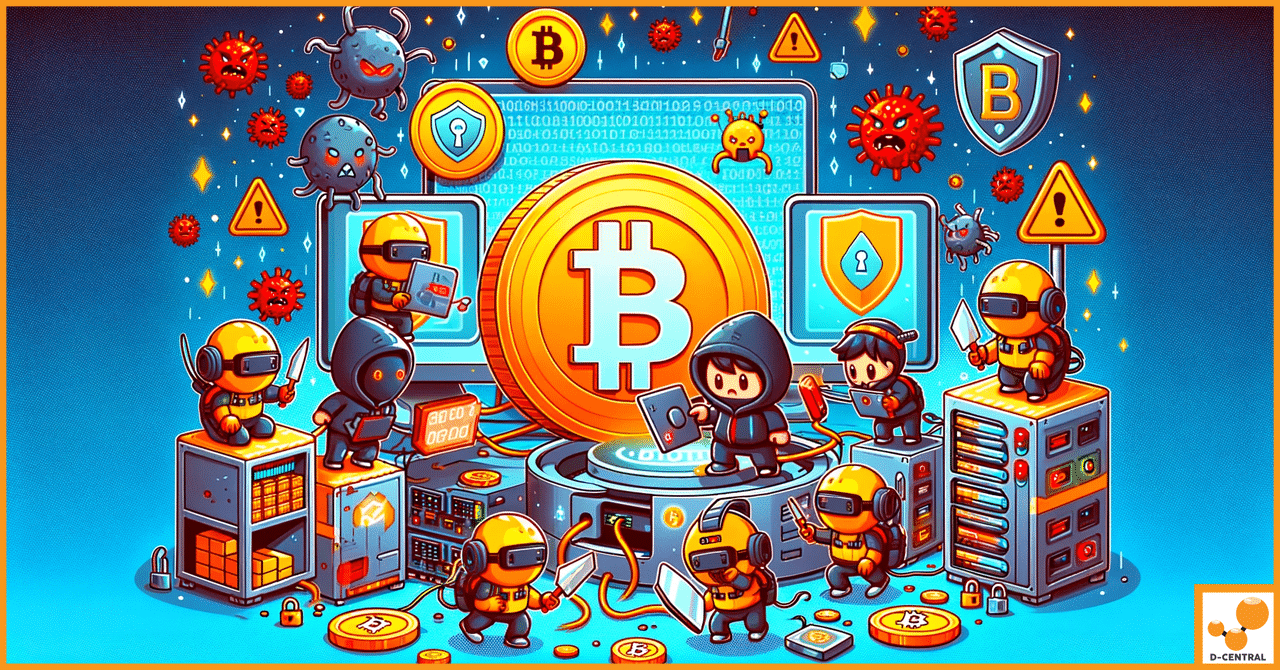
ASIC Mining and Cybersecurity: The Ultimate Guide to Protecting Your Rig from Threats
In the rapidly evolving landscape of cryptocurrency, Application-Specific Integrated Circuit (ASIC) mining has emerged as a cornerstone of the blockchain
4479 Desserte Nord Autoroute 440, Laval, QC H7P 6E2

In the rapidly evolving world of cryptocurrency mining, Application-Specific Integrated Circuit (ASIC) miners have emerged as the linchpins of efficiency and profitability. Unlike their predecessors, ASIC miners are designed with a singular focus: to mine cryptocurrency at unprecedented speeds while minimizing power consumption. This specialized approach not only enhances the mining process but also significantly increases the potential for profit, making ASIC miners indispensable assets in the digital gold rush of the 21st century.
However, the sophistication of ASIC technology brings with it a unique set of challenges, particularly when it comes to maintenance and repair. The intricate design and complex functionality of these devices require a level of expertise far beyond that of traditional computer hardware repair. As the cryptocurrency market continues to expand, so too does the demand for skilled technicians capable of diagnosing and repairing ASIC miners. This burgeoning need has led to the emergence of ASIC repair courses, designed to equip individuals with the specialized skills necessary to maintain and optimize these critical components of the crypto mining infrastructure.
ASIC repair courses offer a comprehensive curriculum that covers a wide range of skills essential for success in the field. From advanced soldering techniques and component replacement to diagnostics, troubleshooting, and firmware management, these courses prepare students to tackle the most common issues faced by ASIC miners. Beyond the technical skills, participants also gain valuable insights into the architecture and operation of ASIC devices, enabling them to understand not just how to repair, but also how to optimize these machines for peak performance.
As the cryptocurrency landscape continues to grow and evolve, the role of the ASIC repair technician becomes increasingly vital. With the right training and expertise, these professionals not only ensure the longevity and efficiency of mining operations but also contribute to the overall stability and success of the cryptocurrency market.
The realm of cryptocurrency mining has been revolutionized by the advent of Application-Specific Integrated Circuit (ASIC) miners, devices engineered to optimize the mining process. Understanding the pivotal role these miners play and the burgeoning demand for skilled repair technicians is essential for anyone looking to navigate or contribute to the cryptocurrency ecosystem effectively.
ASIC technology represents a significant leap forward in mining hardware, designed specifically to mine cryptocurrencies at a highly efficient rate. Unlike general-purpose hardware such as CPUs or GPUs, ASIC miners are tailored for a particular crypto algorithm, making them incredibly effective at executing the computational tasks required for blockchain transactions. This specialization not only increases the speed of mining operations but also significantly reduces power consumption compared to less specialized hardware.
The advantages of ASIC miners are manifold. Their efficiency in processing blockchain transactions ensures a higher probability of earning mining rewards, making them a lucrative investment for individuals and mining farms alike. Moreover, their reduced power consumption translates into lower operational costs, further enhancing their appeal in a market where profitability is closely tied to energy expenditure.
The sophistication and cost of ASIC miners make their maintenance and repair a critical aspect of mining operations. Unlike more generic hardware, where malfunctions might lead to a simple replacement, the high initial investment in ASIC technology makes repair a more cost-effective solution. This economic imperative, coupled with the specialized nature of ASIC hardware, has led to a high demand for skilled technicians capable of performing these repairs.
Repairing an ASIC miner not only extends its operational life but also ensures that it continues to mine efficiently and profitably. Given the rapid pace of technological advancements in the cryptocurrency sector, the ability to update and maintain ASIC miners is invaluable. Technicians with the skills to diagnose issues, replace components, and update firmware can save mining operations considerable resources, reducing downtime and maximizing the return on investment in these high-cost devices.
Furthermore, the growing adoption of cryptocurrencies and the continuous launch of new coins and mining algorithms ensure that ASIC miners—and the skills to repair them—remain in high demand. As the cryptocurrency market expands, the need for knowledgeable and skilled ASIC repair technicians will only continue to grow, highlighting the importance of specialized training and education in this field.
ASIC repair courses are meticulously designed to equip participants with a comprehensive skill set, ensuring they are well-prepared to tackle the challenges of maintaining and repairing ASIC mining equipment. These courses cover a range of essential skills, from basic soldering to advanced diagnostics and firmware management.
A fundamental component of ASIC repair is mastering soldering techniques, particularly for Ball Grid Array (BGA) and Surface-Mount Device (SMD) components, which are prevalent in ASIC miners. Soldering involves the precise application of heat to attach metal components to the miner’s circuit boards, a skill requiring both knowledge and practice to perfect.
Courses typically include hands-on training in these techniques, ensuring that technicians can confidently replace damaged components, a critical skill in extending the lifespan of ASIC miners.
The ability to diagnose and troubleshoot is paramount in ASIC repair. This skill set involves identifying and resolving common issues that can affect miner performance, such as power failures, overheating, and hash rate inconsistencies.
This comprehensive training ensures that technicians can quickly identify and rectify issues, minimizing downtime and maintaining optimal mining operations.
Firmware is the low-level software that controls the ASIC miner’s hardware. Understanding how to update and configure firmware is crucial for optimizing miner performance and ensuring compatibility with different mining pools and algorithms.
This knowledge allows technicians to not only repair but also improve the functionality and efficiency of ASIC miners.
Beyond basic repairs, ASIC repair courses delve into advanced techniques for dealing with more severe issues, such as water damage or burnouts, which can be catastrophic if not properly addressed.
These advanced skills are essential for repairing miners that have suffered significant damage, ensuring they can return to productive operation without the need for costly replacements.
By covering these core skills, ASIC repair courses prepare technicians to handle a wide range of maintenance and repair tasks, ensuring the longevity and efficiency of cryptocurrency mining operations.
ASIC repair courses go beyond the technical repair skills, offering a holistic view of the ASIC mining ecosystem. Participants gain insights into the architecture of ASIC hardware, understand fundamental electrical principles and safety practices, and learn how to manage an ASIC repair service effectively. These additional skills are crucial for anyone looking to excel in the ASIC repair industry.
A deep understanding of ASIC hardware architecture is essential for effective repair and optimization. ASIC miners are complex devices designed for a specific purpose: to solve cryptographic puzzles as efficiently as possible. This section of the course covers:
This knowledge not only aids in repair but also in making informed decisions about hardware modifications and upgrades.
Working with electronic devices requires a solid understanding of basic electrical principles and adherence to safety practices. This part of the course ensures that technicians can work safely and effectively, minimizing the risk of injury or damage to the equipment.
Equipped with this knowledge, technicians can ensure their safety and the safety of the devices they work on.
For those looking to start or manage an ASIC repair service, understanding the business aspects is as crucial as the technical skills. This section covers the essentials of running a repair business, including:
By covering these additional skills and knowledge areas, ASIC repair courses prepare participants not only to perform repairs but also to excel in the broader context of the cryptocurrency mining industry, whether as technicians, business owners, or industry experts.
Embarking on a journey to become a skilled ASIC repair technician requires selecting the right educational path. With numerous courses available, making an informed choice is crucial. This section delves into the key factors to consider when choosing an ASIC repair course and compares the benefits and drawbacks of online versus in-person learning formats.
When evaluating ASIC repair courses, several critical factors should guide your decision:
Considering these factors will help you choose a course that not only imparts the necessary technical skills but also prepares you for the challenges of working in the ASIC repair industry.
The format of the ASIC repair course is another important consideration. Both online and in-person courses have their advantages and disadvantages, depending on your learning preferences, schedule, and availability.
Choosing between online and in-person learning depends on your personal circumstances, learning style, and career goals. Both formats have the potential to provide a solid foundation in ASIC repair, but the right choice will align with your individual needs and preferences.
ASIC repair courses are an invaluable resource for anyone looking to delve into the technical world of cryptocurrency mining hardware. These comprehensive programs equip participants with a wide array of essential skills, from the fundamentals of soldering and component replacement to the intricacies of diagnostics, troubleshooting, and firmware management. Beyond these technical proficiencies, students also gain insights into ASIC hardware architecture, electrical principles, safety practices, and the business aspects of running an ASIC repair service. This holistic approach ensures that graduates are not only adept at repairing and maintaining ASIC miners but also understand the broader context of their work within the cryptocurrency mining ecosystem.
D-Central stands out as a beacon for those aspiring to master ASIC repair and maintenance. Although we do not offer an official certificate, our Certificate of Completion is recognized within the industry, underscoring the quality and relevance of our training programs. Trusted by major public mining companies to train their staff, D-Central is committed to providing top-tier education to individuals and teams alike, regardless of their technical background.
For those intrigued by the prospect of a career in ASIC repair, the path forward is clear. The demand for skilled technicians in this field is growing, driven by the expanding footprint of cryptocurrency mining across the globe. By pursuing training in ASIC repair, you’re not just investing in your personal and professional development; you’re positioning yourself at the forefront of a dynamic and rapidly evolving industry.
We encourage you to take the first step towards becoming a certified ASIC repair technician. Explore the training programs offered by D-Central, where you’ll find a supportive learning environment, expert instructors, and a curriculum designed to meet the needs of today’s cryptocurrency mining operations. Whether you’re looking to enhance your skills, change careers, or start your own ASIC repair service, D-Central’s courses provide the foundation you need to succeed.
Embark on this exciting journey with us, and unlock the door to new opportunities in the world of cryptocurrency mining. Visit D-Central’s website to learn more about our ASIC repair, maintenance, and operation classes, and take the first step towards a rewarding career in ASIC repair.
What are ASIC miners and why are they important?
ASIC miners are specialized devices designed exclusively for cryptocurrency mining. They offer unprecedented mining speeds and efficiency, reducing power consumption, which makes them crucial in the competitive realm of cryptocurrency mining for maximizing profitability.
Why is there a demand for ASIC repair skills?
The complexity and cost of ASIC miners necessitate skilled maintenance and repair to ensure they operate efficiently and profitably. The specialized nature of these devices creates a high demand for knowledgeable technicians who can handle their repair and upkeep.
What skills are acquired in ASIC repair courses?
ASIC repair courses typically cover advanced soldering techniques, component replacement, diagnostics, troubleshooting, and firmware management. These skills enable participants to maintain and optimize ASIC miners effectively.
How does understanding ASIC hardware architecture benefit ASIC repair technicians?
A thorough understanding of ASIC hardware architecture allows technicians to more effectively troubleshoot, repair, and optimize these miners. It provides insights into the device’s operation, enabling better decision-making for hardware modifications and upgrades.
What are the pros and cons of online vs. in-person ASIC repair learning formats?
Online learning offers flexibility and accessibility but may lack hands-on experience. In-person learning provides valuable practical experience and direct interaction but can be less flexible and more costly due to travel and accommodation needs.
How can one become a certified ASIC repair technician?
Becoming a certified ASIC repair technician involves enrolling in and completing a recognized ASIC repair course that covers essential maintenance and repair skills. Although D-Central does not offer an official certification, their Certificate of Completion is recognized within the industry.
DISCLAIMER: D-Central Technologies and its associated content, including this blog, do not serve as financial advisors or official investment advisors. The insights and opinions shared here or by any guests featured in our content are provided purely for informational and educational purposes. Such communications should not be interpreted as financial, investment, legal, tax, or any form of specific advice. We are committed to advancing the knowledge and understanding of Bitcoin and its potential impact on society. However, we urge our community to proceed with caution and informed judgment in all related endeavors.
Related Posts

In the rapidly evolving landscape of cryptocurrency, Application-Specific Integrated Circuit (ASIC) mining has emerged as a cornerstone of the blockchain

In an era of economic uncertainty and rising inflation, savvy investors are turning to innovative strategies to protect their wealth.

In an age swiftly propelled by technological advancements and digital solutions, amidst the landscape of global energy infrastructure, there emerges